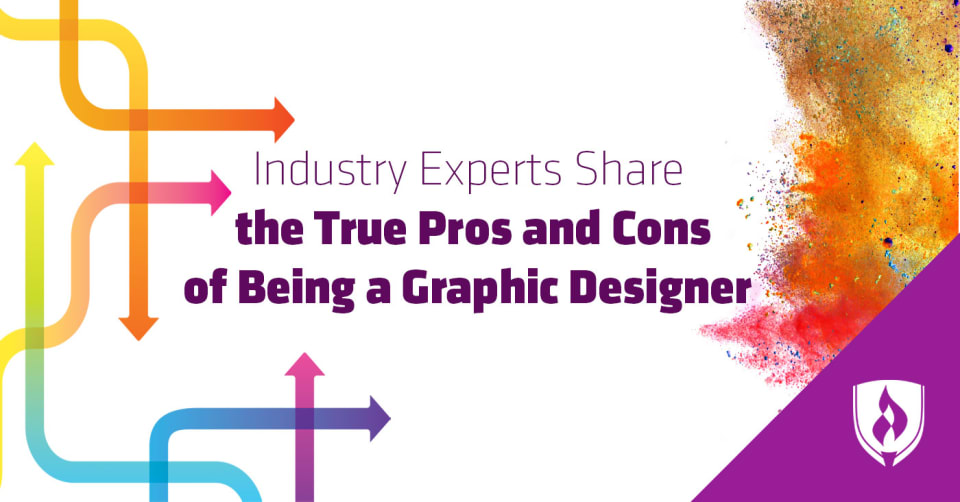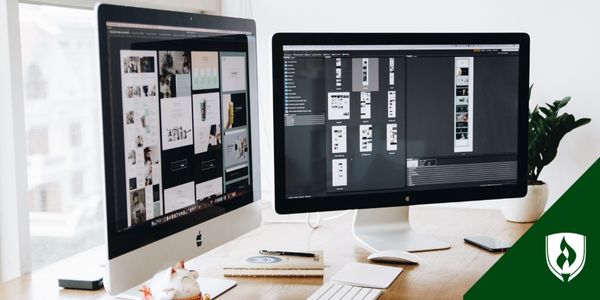Industry Experts Share the True Pros and Cons of Being a Graphic Designer
By Lauren Elrick on 09/19/2017

All careers have their benefits and drawbacks. Whatever job you’re pursuing, it’s important to have an understanding of what you’re really getting into. When it comes to graphic design, there are plenty of phenomenal advantages. After all, if you’re of the creative, strategic mindset that most graphic designers are, you’ll most likely find much of the design work you’re tasked with very fulfilling.
However, just like all jobs, there can be downsides, too. Knowing the highs and lows of a position beforehand can take some of the shock value away from the inevitable job discoveries you’ll make. If creating visual concepts, collaborating with others and inspiring, informing and captivating consumers through design excites you, why not find out a little more about what a job in graphic design entails?
We connected with a variety of experts to figure out the true pros and cons of being a graphic designer so you can walk into the job with your eyes wide open.
The pros of being a graphic designer
1. You get to use both the creative and analytical sides of your brain
The interesting thing about graphic design is that you get to employ “opposite” functions of your brain as you work. There’s a theory out there that the right hemisphere is responsible for creative thinking, art awareness and 3-D forms, whereas the left hemisphere is the side that helps you think with logic, facts and sequencing.
As a graphic designer, you’re not only coming up with creative ways to shape logos and form graphics, but you’re also thinking logically about how to use the tools in InDesign, Illustrator and Photoshop. There can be measurements and numbers involved, and if you’re a freelancer, you’ll have to think logically about how to manage your business, send invoices and keep track of what you owe for taxes.
“It’s about visual problem solving and aesthetics, so if you consider yourself a strong left- and right-brain thinker, it can be a very balanced career to be in,” says Shana Haynie, co-founder and creative director for Vulpine Interactive.
2. Freelance or in-house: the choice is yours
Those who choose creative careers like graphic design often have the luxury of choosing how, when and where they want to work. If you find that you’re a more free-spirited type and work well without the structure of an office, you might really enjoy working as a freelancer. Setting your own schedule, and managing your own clients isn’t always easy, but it can be liberating.
If you learn toward the more logical and structured side of things, working part time or full time at an agency or in-house with a company might be more up your alley. There’s also the option to do a combination of the two as well. You might enjoy the versatility of working from a coffee shop on some days and going into the office and working with your team on other days.
“There is a lot of flexibility in what you can do with this skillset in terms of work environment,” explains Haynie.
3. It’s easy for people to appreciate your work
Let’s face it: Graphic design is visual, and most people are quickly drawn to eye-catching and impactful graphics. As the creator of visual stimuli, it’s only natural that you’ll end up getting lots of recognition for your work.
Whether you’re designing medals for marathons, a new logo and set of brand standards for a company or a large-scale graphic for a hallway in a building, chances are high that people will notice—and compliment you on your excellent work if given the opportunity.
4. Graphic design is a highly coveted skill in many industries
“Graphic design is a skill that is widely coveted in many industries and can be seen as a bonus if you ever decide to move in the direction of marketing or entrepreneurship, for instance,” says Haynie.
All businesses need design work completed in some fashion or form. Whether it’s their main company logo, brochures advertising services or website graphics, the need for designers is high. If you end up pursuing another focus in your career, you’ll only be seen as more valuable for your skills in graphic design.
The cons of working as a graphic designer
1. Design is subjective
Everyone has opinions about what they think “looks good.” Beauty is subjective, so what you make as a graphic designer and consider attractive might not be the same thing your client enjoys.
“Everyone has an opinion about what you create,” says Taylor Kerby, creative director at Cave Social.
The unfortunate part of this truth is that, generally, you’ll need to appease your client—and that might mean designing a logo or graphic that doesn’t have the look and feel you would have naturally chosen. This also means having to scrap or significantly change a design you feel strongly about.
2. Edits can become overwhelming without good boundaries
Client feedback, and the edits that come with it, can be pretty frustrating. It’s important to set good boundaries at the beginning of a project, or you might end up editing and re-editing a graphic for weeks.
“Projects often go through twenty or more rounds of edits because of large company hierarchies,” says Kerby.
It’s a good idea to tell the client exactly how many rounds edits are included in your pricing and hold strong when they ask for changes.
“You may fall into the ‘Just one more quick revision’ or ‘Can we see it this way?’ dilemma if you don’t set an extremely clear scope of work up front,” says Haynie.
3. Everyone thinks graphic design is easy
You’ll find out pretty quickly that many clients—and people in general—think graphic design is simple. Questions like, “Can you just throw a logo together quick for me?” or assumptions about how long it will take you to design something can be disheartening, especially because graphic design requires a very specific skillset. Friends might ask you to create posters for free, and businesses might not recognize the potential you offer.
Gently reminding people about how long design actually takes and how complicated it is can help dispel these conjectures. It’s also important to rally for your pricing and hold fast to your cost.
“No one will want to pay you what you're worth,” says Scott Stickane, owner of creative agency, House of Sticks. It’s up to you to stand up for yourself and the value of your work—which isn’t always easy.
4. Graphic design can be a competitive market to break into
Whether or not their skills are truly developed, graphic designers abound these days. There are a lot of freelance designers out there, as well as a lot of agencies, so the market is competitive, meaning you’ll really have to market yourself. You have to have a portfolio in order to get work, but it’s tough to create a portfolio without work.
If you’re looking for ways to beef up your portfolio, keep in mind that you can always include design projects from your time in school or at an internship. There are also plenty of organizations that will take your designs for free. While it isn’t a habit you should get into, there’s no shame in designing a few free logos or posters for a worthy cause in order to build experience.
Is graphic design in your future?
Now that you know some of the pros and cons being a graphic designer, you’ll hopefully have a more realistic idea about what the job entails. But that’s not all there is to it. If you’d like to learn more insider tips and advice from graphic design professionals, check out our blog article, What I Wish Someone Told Me BEFORE Becoming a Graphic Designer.
RELATED ARTICLES:




